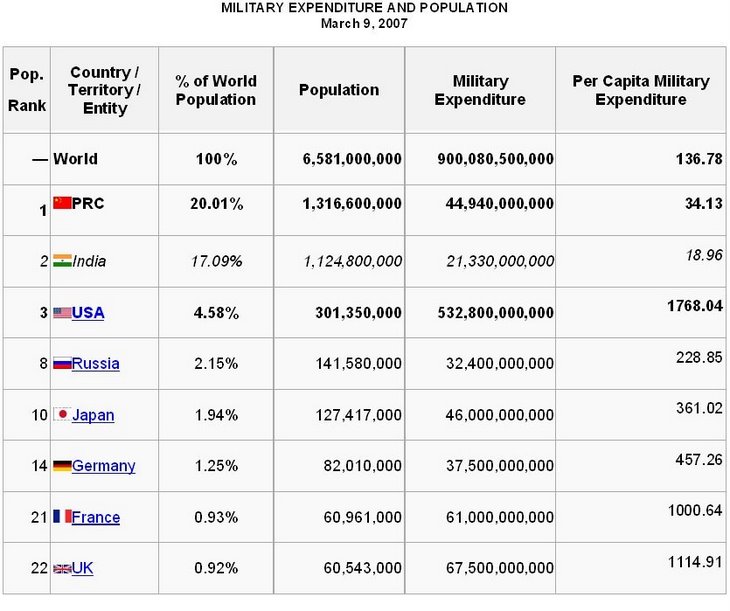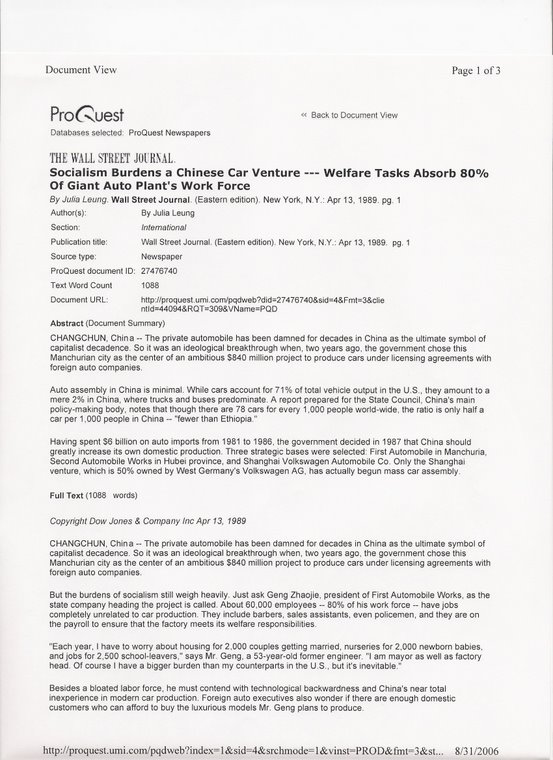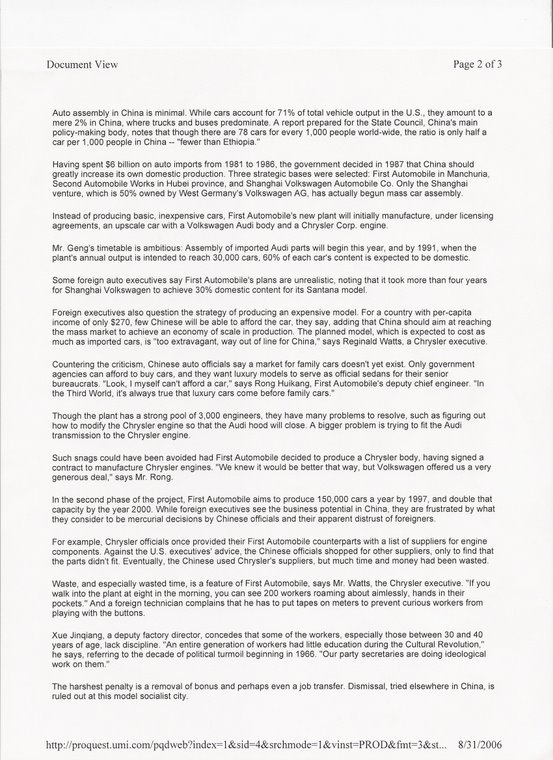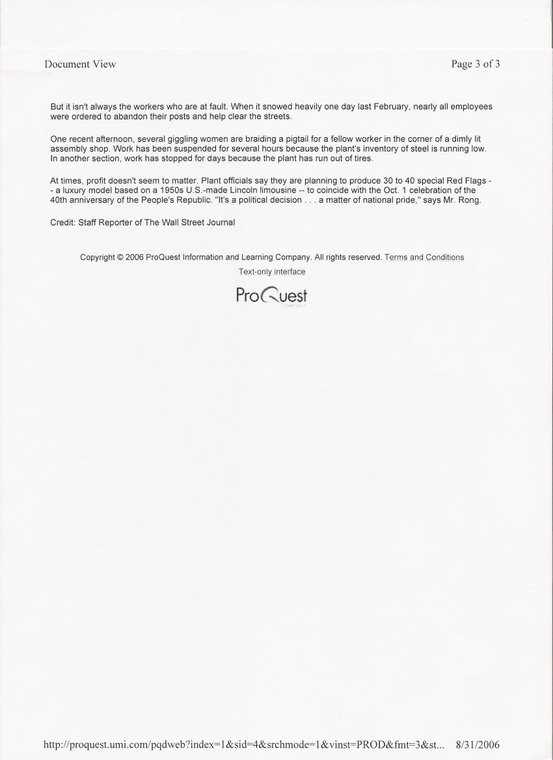On February 16, 2007, Vice President Cheney, after visiting Pakistan, proclaimed that China’s increase in military budget was a threat to the world. This hot-air balloon was reflected in world renowned newspapers such as the International Herald Tribune, Wall Street Journal and New York Times. The reports noted remarks by high level political persons, some of whom are in the Bush Administration, cautioning against exaggeration.
As far back as August 18, 2006, Sha Zukang, China’s Ambassador to the United Nations told the British Broadcasting Corporation Radio (BBC) that US concerns about his country’s “burgeoning military might” were misguided. He goes on to say, “It’s better for the US to ‘shut-up’ . . . China’s military build-up is not threatening anyone.”
On March 5th, US Treasury Secretary Henry Paulson was quoted as saying “I would say that our relationship with China is multifaceted and it’s a very important relationship for the US and I don’t believe we need to make China an enemy. If we manage the relationship - - the overall relationship with China properly, it’s going to benefit both of our countries for a long time to come.”
Of course, the Chinese responded that they were increasing the military budget by 18% from 2006-7. On March 6th, the PLA issued a report stating that “China’s defense expenditures in 2005 of $30.6 billion accounted for only 1.35% of the country’s GDP, while the United States and Britain spent 4.03% and 2.71% of their GDPs on defense.” Their intent is to increase the technical capability of their military forces and keep up with modernization. In fact, on March 2nd, China’s Commission of Science, Technology and Industry for National Defense issued a new policy, encouraging private companies to invest in the national defense industry.
In February, responding to the backlash against the destruction of its own space satellite, China had issued a white paper disclosing their space activities and proposing discussions with the USA to come to an understanding of militarization of outer space. One can hardly consider the obliteration of its own satellite by self- guided missile, a threat. Rather, it serves notice that the USA monopoly of outer space military advantages is over. Undoubtedly, the Russians have a similar capability. Nonetheless, the US has shunned invitations to have an international agreement on non-militarization of outer space. We are now awaiting a proper response from the USA.
One can suspect that Vice President Cheney was beginning a new set of presumptions, exaggerations and, if I may use the term, lies about China’s military prowess and intent. China has never been involved in any international military conflicts (with one short-lived incident in the 20th Century). This is par for the course for the Bush Administration. We know they directed the development of intelligence stories with regards to Iraq, where we never found any weapons of mass destruction. It was our invasion that created mass destruction in Iraq itself. We lost over 3,000 soldiers and have caused almost every Iraqi family to lose a member due to the conflict our invasion released.
As for the facts of militarization, we attach a table below which shows the world’s total military expenditure, as well as that of nine countries. This chart compares each country’s published military expenditure, population and the percentage of their population in the world’s total. The last column calculates the per capita military expenditure of each nation. The results are astounding. The United States is almost $1,800. China is approximately $35.
[Please note: This Chart is available towards the bottom of our blog in a larger, more readable format; just scroll down.]

We calculated and grouped the per capita military expenditure of India (which has the lowest per capita of roughly $19), with Russia (approximately $230) and China for a total of approximately $38. Note that these three countries are not dominated by American military structure and, in their independence, have joined together for development. Hence, we view them as a special group to compare to the US military position. Whichever way you look at it, the United States per capita expenditure is 46 times the combined per capita expenditure of India, Russia and China.
Where is the logic in assuming that a country with 1.3 billion people and 20% of the world’s population, spending only $35 per capita for its military establishment, is seeking domination anywhere in the world against existing interests of the USA with only 4.6% of the world’s population but an expenditure of 533 billion dollars for 2007 (or a per capita expenditure of $1,769).
Please, someone out there, give me the logic. If you can’t, then it doesn’t exist and we must conclude that Mr. Cheney and the forces in the Bush Administration, for which he is spokesman, are on the verge of concocting a new series of lies to destabilize peaceful relations. This is hardly the way to resolve real differences that have developed in our economic relations. There, again, please note that the negative trade balance of the US to China and the US indebtedness of over half a trillion dollars could be relieved if we were to sell them the heavy equipment and technology which they continue to tender as a major step in balancing our accounts. Furthermore, China is ready to invest in USA industries to produce commodities that they can import which would reduce the negative trade balance considerably. The solutions are there. The political economic policies of the USA are not defensive, but offensive in making it appear that China is an enemy and we should fear their military.
China’s foreign policy is to rise peacefully as an economic power. It has proven and intends to continue to make win-win trade and investment deals with all countries, particularly developing countries which will have an opportunity to improve their own states. Call a spade, a spade. Cheney is throwing up a balloon which lies in the hope that it diverts attention to the recalcitrants of the USA to work as equals with China, recognizing the inevitability of China’s future rise. The resolution of conflicting interests, from the Chinese point of view, is to be handled diplomatically without any allusions to the military.
Warfare in orbit is only news when China does it
The Real 'Masters of Space'
By Karl Grossman
(Appearing in April 2007 issue of Extra! The Magazine of FAIR--The Media Watch Group)
As a graphic proclaiming "Red Storm" flashed on the screen, CNN anchor Lou Dobbs intoned: "Communist China tonight refusing to explain its motives for conducting its first-ever anti-satellite missile test. That test, the latest in a series of dangerous new challenges by the Chinese military to this country’s interest."
He threw it to correspondent Christine Romans, who declared, "Defense experts see a pattern of behavior that highlights China’s strategy to exploit American weakness." Romans went to John Tkacik of the Heritage Foundation, who, she reported, "says that American policymakers refuse to recognize China’s hostile intentions toward this country."
The segment on Lou Dobbs Tonight (1/24/07) didn’t mention anything about the U.S. military's space strategy of recent years (Extra!, 5-6/99). There’s not a word about a key 1998 U.S. strategy document, the U.S. Space Command’s Vision for 2020, which envisions space-based laser weapons zapping targets on Earth, and speaks of the U.S. military "dominating the space dimension of military operations to protect U.S. interests and investment" and "integrating Space Forces into war-fighting capabilities across the full spectrum of conflict."
Nor was mention made of the 2001 Rumsfeld Commission report, which declared, "In the coming period, the U.S. will conduct operations to, from, in and through space to support its national interests both on the earth and in space." The Commission to Assess United States National Security Space Management and Organization, chaired by Defense Secretary Donald Rumsfeld, also urged that the U.S. president "have the option to deploy weapons in space."
Also left out was a new U.S. National Space Policy adopted by the White House last year that took a still more aggressive U.S. position on space warfare, announcing that the U.S. will "develop and deploy space capabilities that sustain U.S. advantage."
Just as the continuing U.S. development of space military capabilities wasn’t reported, nor were the repeated efforts led by China, Russia and U.S. ally Canada to have the 1967 Outer Space Treaty, the basic international agreement setting aside space for peaceful uses, broadened to include a ban on the deployment, testing or use of weapons in space--or the U.S. opposing this initiative, all but alone at the U.N., in vote after vote.
Instead of placing the story in context, explaining the precipitating factors, China’s successful destruction of one of its old satellites was simply labeled--in a banner across the screen--as "Communist China’s Rising Threat to the United States."
The New York Times (1/19/07) was only somewhat better. After the jump, its lead story ("Flexing Muscle, China Destroys Satellite in Test") did inform readers that China has "been trying to push a treaty to ban space weapons." No reference, however, was made to the U.S.'s lonely and sustained opposition to this.
And the quote on which the story is hung, in the fourth paragraph on Page 1, is Jonathan McDowell, a Harvard astronomer, declaring: "This is the first real escalation in the weaponization of space that we’ve seen in 20 years." Where exactly has McDowell been as the U.S. has ratcheted up its space warfare program over the past two decades?
The space industry trade newspaper, Space News (1/22/07), emphasized the folly of banning weapons in space in its front-page story about the test ("China’s ASAT Test Widely Criticized, U.S. Says No New Treaties Needed"). It filled six of the first eight paragraphs of the piece with long, virtually unbroken quotes from an anonymous "U.S. State Department official."
A key quote from the unnamed official: "Arms control is not a viable solution for space. For example, there is no agreement on how to define space weapons." How about "weapons in space"?
Aviation Week & Space Technology (1/17/07) revealed the January 12 Chinese test on its website in an article that omitted any mention of the U.S. space military program. But it did state, "China’s growing military space capability is one major reason the Bush administration last year formed the nation’s first new National Space Policy in 10 years."
In a subsequent full-page editorial, headlined "China’s ASAT Test: Irresponsible and Against International Norms," Aviation Week (1/29/07) declared that news of the test "that we broke on our website…should not come as a surprise. While the precise timing of the test may have startled most of the world…the People’s Liberation Army has been signaling its intent to master the space realm for more than a decade."
Aviation Week might have acknowledged that "Master of Space" is not a motto coined by the Chinese, but by the U.S. Air Force Space Command’s 50th Space Wing in 1992the words emblazoned to this day above the entrance of its headquarters in Colorado.
The publication made no explicit mention of China’s efforts to ban weapons in space and U.S. opposition to that, but it did remark that the general hand-wringing about "militarizing space" or an "arms race in space" that we have noticed in some quarters strikes us as downright silly.
First of all, space has been militarized practically from day one…. And even if the genie could be put back in the bottle, why should it be?... Today, the U.S. is understandably reluctant to invite the nations of the world to discuss restrictions on a technology in which it is preeminent. No armed forces enjoy the advantages of the orbital high ground more than those of the U.S.
"When I say last week’s coverage was bad, I mean textbook bad, without even token context," Brian Dominick wrote for the New Standard website (1/25/07). "The only background we’re offered--in some articles--took the form of acknowledgement that the U.S. has the capability to nix Chinese satellites. But even that came in a paraphrase attributed to an expert who appears to be some kind of U.S.-space-domination cheerleader."
Among the pieces he singled out was an Associated Press story (1/23/07) that spoke about the test by China "carried out under the auspices of its highly secretive, military-dominated space program." Dominick observed: "It’s hard to think of better terms to describe the U.S. space program other than by adding ‘profit-aware.’ But you’ll never see ‘secretive’ or ‘militarized’ as adjectives describing NASA--at least not in the AP."
Great detail need not be offered to provide context. For instance, the British journal New Scientist (1/27/07) simply noted:
Despite protests from the Bush administration over China’s action, analysts point out that the U.S. has consistently refused to discuss a new UN treaty on the peaceful uses of outer space. Instead, it will this year spend at least $1 billion on anti-satellite weapons research.
The mainstream U.S. media coverage of the Chinese test--riddled with omissions and jingoism--is no surprise to Bruce Gagnon, who for 15 years has been coordinator of the Global Network Against Weapons and Nuclear Power in Space (www.space4peace.org). He tells Extra!:
While China's ASAT test is troubling, it is also hypocritical of the U.S. to criticize them for doing something that our country has been doing since the 1980s. The Pentagon today is developing a host of ASAT weapons technologies that would give them the ability to knock out other countries’ satellites. Sadly, the American people don't know anything about this because the corporate-dominated media refuse to cover the story.
Every year, he notes, the Global Network presses the space militarization issue by holding a Keep Space for Peace Week. "We send information out to the mainstream media locally and nationally but they completely ignore our efforts," he says. "You'd think that the fact people are holding positive actions to educate the public about preventing a news arms race would be newsworthy." Last year, during the week of demonstrations and talks, the bellicose new National Space Policy was announced (DATE), and thus "all the more reason for a story about a global movement working to prevent the weaponization of space. But nothing was reported on it."
"Why do the mainstream media not report on a growing international movement to keep space for peace?" Gagnon asks.
Could it be that much of the media today is under the control of the very corporations who will benefit, directly or indirectly, from a new arms race in space? The Pentagon has long bragged that Star Wars will be the largest industrial project in the history of the planet. In order to create the fear and acceptance of such a plan, the media must manage the news around this issue so that the American people remain compliant.
The move by the U.S. to turn the heavens into a war zone "has all the elements of a big story--money, power, domination, corruption," says Gagnon. "But the corporate-dominated media rarely go near it. The big money is keeping a lid on this story for a reason."
Karl Grossman, professor of journalism at SUNY College at Old Westbury, is author of Weapons in Space (Seven Stories Press) and The Wrong Stuff (Common Courage Press) and host of the TV documentaries Star Wars Returns and Nukes in Space: The Nuclearization and Weaponization of the Heavens ( www.envirovideo.com).











